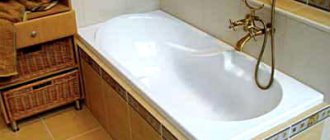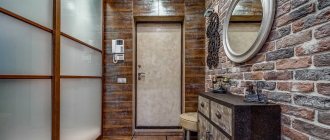The ceiling is the most open base of the room, which homeowners most often finish in the traditional way - leveled and whitewashed. Moreover, the higher the class of such finishing, the more noticeable the damage that appears on it over time. The most common defect in plastered and whitewashed ceilings are cracks.
Due to their visibility, they try to get rid of these damages as quickly as possible, often without thinking that cracking may be a sign of more serious problems than a cosmetic defect in the finish.
Let's consider ways to repair cracks in the ceiling, taking into account the magnitude of the damage and the causes of cracking.
Types of cracks and reasons for their formation
The amount of work to seal cracks depends not only on the size of the damage, but also on the factors causing crack formation. If you do not neutralize the cause of the cracks, then the work to seal them may be done in vain.
To find the cause of cracking, it is necessary to analyze the following factors:
- duration of operation of the building;
- location of the crack on the plane;
- type of floor (if prefabricated, the orientation of the cracks relative to the floor slabs);
- crack width;
- localization material and depth;
- dynamism.
After the building is put into operation, the foundation is subject to shrinkage for at least another year, during which the prefabricated floor slabs may move slightly relative to each other, forming cracks along the joints between themselves and with the walls. Therefore, in apartments of new buildings, it is not advisable to carry out thorough finishing for the first 2-3 years; during this time, it would be reasonable to observe the appearance and further behavior of cracks in order to make sure that the structures are stabilized before starting repairs.
Layers of finishing applied on top of a concrete ceiling are also susceptible to cracking caused by a number of factors: vibration and temperature effects, physical wear and tear of materials, and exposure to moisture. And the concrete of the floor slabs under the ceiling finishing may also have hairline, technological and deformation cracks that formed in it before the installation of the products.
From all this it follows that cosmetic repair of cracks without analyzing the causes of crack formation often does not solve the problem and is even dangerous, since it hides the signs of ongoing structural destruction.
Since repairing a crack in the ceiling is a responsible operation, we will consider in more detail effective ways to eliminate these damages in the most common situations.
Let's move on to practice
To give practical advice on how to repair a crack with your own hands and make the ceiling perfect, it is necessary to dwell in detail on the third point, which we have not forgotten, namely the type of work.
Choose the type of work based on your financial capabilities, professional skills and conscience. Main options:
- cosmetic repairs according to the principle “it will do”;
- major repairs according to the principle “expensive, but easy and reliable.”
Read Two-level stretch ceilings in the interior
You can carry out all the work based on the photo and our article.
Sealing shrinkage (hairline) cracks in concrete
On concrete floors, prefabricated and monolithic, cracks are often found, shaped like a spider's web. Such interlacing is formed during concrete curing, it is called shrinkage and occurs for the following reasons:
- errors in the proportions of concrete components (exceeding the norms of cement content);
- improper provision of hardening of the concrete mixture;
- errors in reinforcement.
The width of such cracks does not exceed 0.1 mm, which is why they are called hairline cracks. Such a defect in the concrete surface does not pose a danger to the operation of structures in the near future, but after some time, if no action is taken, the reinforcement steel under the cracked protective layer of concrete will begin to oxidize, increase in volume and destroy the concrete shell around it.
During oxidation, reinforcement increases in volume and puts pressure on the concrete around it, squeezing it towards the thinnest layer thickness. Reinforcing wire is knitted into meshes in a pre-stressed state, so the destruction of even one reinforcing element changes the stress balance in the concrete, which entails further destruction of the structure.
To avoid this, it is necessary to prevent contact of the reinforcement with moisture through cracks. To do this, it is necessary to apply a protective coating to the concrete slab, which not only penetrates into microcracks, but also creates a thin film on the base. As such a material, one-component water-based protective acrylic compositions Sikagard® 680S, Sikagard®-203 W, available in various colors and used as both an intermediate coating before painting and for finishing surfaces, can be used.
This operation is used if the concrete layer with hairline (shrinkage) cracks has not yet peeled off from the reinforcement.
If, when tapping the ceiling surface with such cracks, the protective layer of concrete collapses, revealing corroded reinforcement, then repair of the consequences of such cracking is carried out depending on the degree of corrosion and loss of cross-sectional area of the reinforcing elements - a special repair composition (fiber-reinforced concrete) is selected, the high tensile strength of which compensates for damage to reinforcement.
On top of corroded reinforcement, you can manually apply compositions such as Sika® MonoTop®-612 (cement-based with additives of polymers, silica and reinforcing fiber, fine-grained, layer up to 30 mm), Sika® MonoTop®-412N (cement-based, low degree shrinkage, with reinforcing fiber, thick layer - layer thickness up to 50 mm).
The use of a solution in combination with additional reinforcement of the base with fiberglass mesh or canvas increases the strength characteristics of the repair shell.
Methods of application are described in detail on the packaging, and if the material is used correctly, the consequences of hairline cracks on the ceiling are reliably neutralized.
After the repair layers have cured and dried, a final coating is made with gypsum putty, followed by sanding and painting the ceiling.
Recommendations from specialists for carrying out work
Many people are interested in knowing how to seal the seam on the ceiling between the slabs; the instructions presented below will help you with this. Before cleaning, the surface should be treated with water from a spray bottle. It is better to wet only the part of the ceiling that you plan to work on at the moment.
The moistened area is left for 15 minutes, and then you can get rid of the old coating and move on to the next area. The entire procedure is repeated again in the new zone. Until the entire ceiling plane is cleaned, the work must be repeated again and again. As soon as you can get rid of the old coating, you will be able to estimate the amount of work to be done. As a rule, there are several joints per room, the number of which sometimes reaches three.
When thinking about the question of how to seal the seam on the ceiling between the slabs, the options presented above are worth considering. At the preparation stage, the seam should be cleaned, deepening by 50 mm. Next, using a wide brush or iron brush, the seam is cleaned of small concrete residues.
To seal the seam, you can use special polyethylene foam rollers
It is important to choose products of the desired thickness. A strip of sealant is applied to one side
Afterwards, the roller can be inserted into the previously primed joint. You need to use a spatula for this. The craftsman should ensure that there is room left to fill the space with concrete.
When sealing joints with expanding concrete, it is necessary to install recesses for decorative plaster. Once the solution has dried and the groove has been prepared, elastic putty can be applied to the surface. The work should be carried out using two spatulas, one of them should be wide, the other medium or narrow.
Repair of cracked plaster layer
Cracks in the ceiling within the boundaries of the floor slabs are still often limited in depth by a layer of plaster, and repairing such damage requires less cost, since it can be done without the use of specialized compounds.
How to repair cracks in a plastered ceiling before whitewashing
First of all, you need to examine the condition of the plaster layer by tapping it with a hammer along the cracks. Areas with peeling plaster must be cleaned down to the concrete base; after cleaning, there should be no cracks under the edges of the area - check with a spatula or tapping.
Then the surface of the cleaned concrete base is primed with a ready-made latex-based composition or an aqueous solution prepared independently in a 1:3 ratio.
The optimal material for filling the formed depressions is cement-based leveling mixtures, as materials similar to concrete in composition and density.
The compositions prepared according to the instructions on the packaging are applied with a spatula in layers - depending on the depth of the cavity, waiting for the previous layer to cure. If the depression is deep enough, reinforcement with a mesh attached to the base is used.
The last layer of cement leveling mixture must dry completely - acquire a uniform color over the entire area - before finishing with gypsum putty.
If there is no peeling of the plaster layer on the sides of the crack, the repair is greatly simplified. The gap must be widened to 5 mm wide, cleaned of debris with a brush and primed.
Then, using a spatula, the damage is filled to its full depth with cement putty, and after drying, finishing is done with a gypsum mixture.
Important! If a crack with a width of 1-3 mm is not expanded to 5 mm, then filling it with the mixture to the full depth is difficult, and incomplete filling of the gap will soon lead to repeated cracking.
Using gypsum mixtures or compositions based on white cement for the finishing coating simplifies further whitewashing - even with low quality paint, additional layers will not be needed.
Preparing the mixture
When working with a ready-made polymer composition, this stage can be skipped. Dry mixtures will need to be properly prepared first.
A small container is filled with water, then the dry mixture is poured in portions. It is necessary to fill until dry islands form on the surface of the liquid.
You need to mix the solution with a spatula; using a drill mixer is not recommended, otherwise the mixture will become saturated with air and harden faster.
After the first stirring, the mixture is left to soak in moisture for 5 – 10 minutes.
Then the solution is brought to a homogeneous state. When kneading, try to break up all the lumps.
How to repair a crack between reinforced concrete slabs on a ceiling
Even after the shrinkage of the building’s foundation has completed, cracks periodically appear along the joints of the floor slabs due to the action of vibration, temperature deformations and other factors. The frequency of their occurrence depends on the quality of work to eliminate these damages.
To increase the durability of the seal, the seams between the slabs are arranged to the maximum depth.
Using any tool available for use (hammer, chisel, metal wire brush, hammer drill, grinder, etc.), old mortar and, if present, loose caulked materials are removed from the joints of the slabs.
Then the cracks are blown with a stream of air and moistened with water using a bottle with a spray nozzle.
Without waiting for the concrete surface to dry, fill the joints of the slabs with polyurethane foam to 2/3 of the depth, immersing the guide tube of the can into the gap until it stops.
Important! Polyurethane foam must be used of proven quality - after hardening, it forms a solid mass of uniform density with low porosity.
After a day, when the foam has hardened, its excess is removed by cutting it with a stationery knife so that the cut of the foam is recessed into the gap by 3-4 cm. Then the remaining open surfaces of the seam are primed with a latex primer.
After the primer has dried, the seams flush on the concrete surface of the slabs are covered with a cement-based leveling mixture. After 1-2 days, the final leveling of the joints is carried out with gypsum putty - continuous across the entire ceiling or, in the case of spot repairs, flush with the finishing surface of the ceiling. Along the seams, when applying the gypsum composition, the joints are glued with reinforcing serpyanka tape, cutting it into pieces to repeat the configuration of the crack.
The dried topcoat is sanded, then the ceiling is completely primed and painted.
Design factors
Design factors do not depend on the owner of the premises and the craftsman who performed the installation. The finishing coating material is fragile, putty is not able to compensate for changes in the geometry of the frame structure. The crack is the putty’s reaction to such changes.
- Building shrinkage is the most common reason why a crack occurs. Moreover, the ceiling is not the only surface in the room that is destroyed by this.
- The close proximity of transport routes leads to vibration of the structure, and this also causes the ceiling to crack.
All surfaces suffer from building shrinkage
- Other force majeure circumstances, which include earthquakes, explosions, flooding.
Important
! Due to the fact that redevelopment has become fashionable today, and the necessary technical control over reconstruction in apartments is not carried out, weakening of the load-bearing elements of the building occurs due to the illiterate dismantling of partitions by neighbors.
Sealing cracks at the junctions of walls and ceilings
Cracks under the ceiling along the perimeter of the walls do not reduce the aesthetics of the finish, since these cracks are usually hidden under decorative ceiling plinths. But it is still necessary to seal the cracks between the wall and the ceiling in case of flooding due to a leak from above.
Since sealing cracks in this place does not have an aesthetic component, the task is simplified.
The joints between the ceiling and the walls are opened with a suitable tool (narrow chisel, wall chaser, grinder, etc.), blown with a stream of air and, by analogy with ceiling seams, filled with polyurethane foam after wetting.
Important! The width of the jointing must be made taking into account the dimensions of the ceiling plinths planned for installation.
When using polyurethane foam, the algorithm of actions does not differ from sealing joints between floor slabs.
In this situation, instead of foam, you can use silicone or rubber sealant, but you must first prime the inner surfaces of the seams and wait for the bases to dry.
As a sealing composition for sealing gaps in this place, you can also use self-made mastic from PVA glue and cement; the consistency of the mixture should be paste-like so that the composition does not leak out. The cavities must be primed first to improve adhesion. After curing, such a homemade sealant is durable, quite elastic and waterproof.
The angular conjugation of the bases is given the geometry of one of the leveling mixtures and, after the layer has dried, it is coated with an aqueous solution of latex in a 1:1 ratio for hydrophobicity.
Options for solving the problem
When choosing tactics that will help eliminate cracks once and for all, first of all take into account the established causes of ceiling defects:
- If the frame is rigid, and the crack grows slowly but constantly, and its shape does not follow the joint between the sheets, then the reason for its appearance is shrinkage or vibration of the building. In this case, there is no point in waiting for the end of the process, and it will not be possible to remove the defect with putty. The only way to ensure that the crack does not appear again without having to disassemble the ceiling is to disguise it by gluing decorative polyurethane or polystyrene foam boards.
Polyurethane tile finishing
- If play in the structure or sagging of drywall is detected due to incorrect frame assembly technology, the ceiling is dismantled.
- If it turns out that the crack arose due to poor-quality sealing of seams or non-compliance with puttying technology, it can be removed by local jointing and sealing, followed by painting the ceiling.
Having determined the causes of cracking, you can competently begin to restore the ceiling surface.
Repairing cracks in floor slabs
There are situations when, when removing worn plaster from the ceiling, cracks are found directly in the floor slabs. Such damage may be a signal to take more serious measures than cosmetic sealing of cracks, so let’s take a closer look at how to repair a crack in a ceiling slab, and whether it is possible to do it on your own.
The formation of a crack in a reinforced concrete structure indicates a release of stress that has accumulated in this place due to various factors. The occurrence of cracks is caused by tensile forces arising in the structure from the total impact of internal processes in the product and external loads on it.
According to SNiP 2.03.01-84* “Concrete and reinforced concrete structures”, cracks with identical parameters may be allowed on one type of reinforced concrete products, but not allowed on other structures. Let's consider the situation with floor slabs in order to guide us in assessing the possibility of repairing them on our own.
In addition to the shrinkage (hairline) cracks described above, there are also the following types of cracks:
- technological - from temperature deformations or insufficient vibration when pouring concrete into a mold, uneven prestressing of reinforcement, resulting in delamination of the finished product;
- deformation – mechanical damage during transportation, installation and operation.
Cracks in monolithic reinforced concrete floor slabs, with the exception of hairline cracks, are very rare. But, even if they appear, if the width of the cracks in the ceiling is up to 2 mm, they are simply sealed independently with a cement solution using a construction syringe - to prevent moisture from accessing the reinforcement.
Important! When preparing to seal a crack in a floor slab, jointing it with a grinder, wall chaser or other power tool is not allowed - only superficial expansion of the crack using manual means (trowel, steel wire brush) is allowed.
Hollow and multi-hollow slabs are more susceptible to cracking and require more careful inspection when repairing ceilings.
Small longitudinal cracks on them are acceptable and must be sealed with cement mortar.
If there are transverse cracks on the slab, then it is necessary to carry out a construction examination of the floor by specialists, since such damage is serious and may require strengthening or replacing the entire concrete element, which cannot be done by the residents.
To determine the dynamics of a longitudinal or diagonal crack, use the installation of control beacons; they can be made with your own hands from a strip of paper or a plaster lintel indicating the installation date (a paper beacon is less accurate).
After sealing small cracks in the slab, the ceilings are primed, puttied and painted, as after sealing cracks in plaster.
We work on a warning, or useful tips
Recommendations that should be taken into account if you want to prevent the appearance of cracks:
- Installation of drywall must be carried out in strict accordance with technological requirements.
- Trust the professionals.
- Before installing drywall, check the hangers. Proceed with work only if they are well secured.
- Fasten the drywall sheets with self-tapping screws at equal intervals.
- The sheets should be fastened every 10-15 cm.
- Don't forget to chamfer all sides of the sheet.
- Treat the seams with a primer. A deep penetration primer is best.
- Treat seams before using plaster mesh.
- Use acrylic putty when filling cracks.
- When choosing a sealant, remember that silicone options are not painted.
- If there is fungus on the ceiling, seal the crack with sanitary sealant.
- Use a complete plaster mesh. Try to make sure that the ceiling is covered with a single sheet.
You can also remove minor damage with your own hands. However, in no case should you ignore the dynamic deterioration of the situation and cracks in the slabs themselves, and not at their junction. In your case, repairs may not be able to solve the problem.
What building materials are suitable for repairing damage?
Today in any supermarket you can see materials for sealing cracks; they are designed to work with various types of surfaces. Both universal mixtures and special ones for external or internal use are sold.
Several of the most used types of putties from different manufacturers:
- Neomid Professional - for eliminating both street and internal damage. This putty is distinguished by its versatility, it is suitable for various materials. The content of reinforcing fibers allows you to work with deep and wide cracks.
- Semin Fibrelastic is a universal putty with increased elasticity, can be used both indoors and outdoors. Withstands significant loads when “breathing” cracks expand and contract, and does not lose its qualities due to changes in temperature and humidity.
- Profix - easy to apply and has plasticity and high adhesion to most materials from which walls are built. The mounting-putty mixture works great outdoors and is suitable for self-repair of small cracks; it can be applied textured.
- Unis Glare-thick-layer is a gypsum putty; manufacturers provide a 15-year guarantee on Unis seams. Used to correct internal defects.
You can prepare a mixture for sealing cracks yourself.
Cement-sand mortar is made at the rate of 3 parts sand to 1 part cement; for large or through gaps in the walls, crushed stone can be added, and for plasticity, add liquid soap in the amount of 30 g per 15 liters of concrete or silicate glue (1 liter per 15 liters of solution) , or PVA (100 g per 15 liters of mixture). The properties of the finished putty can be improved by adding fiber reinforcing fibers and ready-made plasticizers.
It is used for external cracks in brickwork, concrete, and aerated concrete. The advantage of this material can be considered its strength, and the disadvantage is its low elasticity, even in the presence of plasticizing additives; moreover, the finished solution cannot be stored for a long time.
There is no need to make silicone sealant yourself; it is sold ready-made in special tubes and is applied using a glue gun with a thin tip, which is convenient for filling cracks. The advantages of silicone are fast drying and high elasticity of the seam, moisture resistance. Disadvantages include the fragility and softness of the material. Silicone is used inside the home to repair small cracks.
—
Polyurethane foam is used to fill internal voids in cracked structures made of aerated concrete or aerated concrete; its advantage is lightness and excellent thermal insulation. The downside of polyurethane foam is its softness and lack of strength; an additional coating of plaster is required on top.











